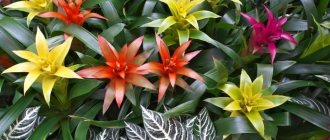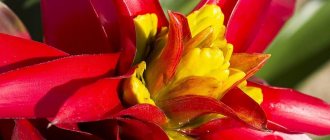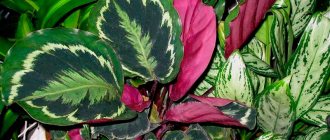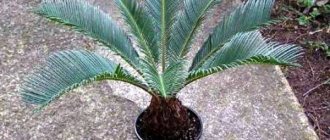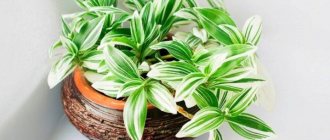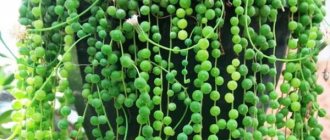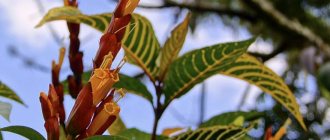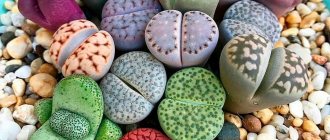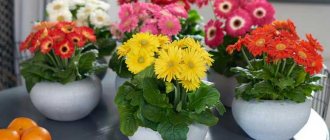Guzmania can safely be called the brightest representative of the bromeliad family. The main decoration of the plant, the pre-bloom of a pink, scarlet or brownish hue, stands out against the background of lush green leaves.
With its presence, a flower can bring tropical motifs to any room. The method of propagation of Guzmania is also unusual, which consists in separating and planting daughter sprouts, or children. The nature of the plant involves a process of rebirth, therefore, after life is given to future flowers, the adult guzmania dies.
Caring for Guzmania at home. Details
Guzman care at home requires quite careful care. However, if you provide it with the necessary conditions, it will delight you with decorative foliage and luxurious flowering for a long time.
Guzmania flowering
Guzmania blooms only once in the second or third year of life. A spike-shaped inflorescence of inconspicuous white flowers is surrounded by bright leaves-bracts. They are what give the plant its spectacular appearance. Their color can be red, yellow, orange or pink.
Flowering duration is 3-5 months. To prolong it, do not allow water to get on the flowers and perianths. After flowering, the rosette gradually dies off.
Temperature
Guzmania is a heat-loving plant. In summer, the optimal temperature for it is 20-25 degrees, but not higher than 28; in winter – 18-20 degrees. It is undesirable to lower the thermometer below 15 degrees: the flower may get sick and will not bloom.
Spraying
Homemade guzmania loves high environmental humidity, ideally 60-85%. The plant needs daily spraying with distilled or filtered water. During the flowering period, drops should not fall on flowers and bracts.
It is recommended to place wet sphagnum on the surface of the soil in the pot. You can place containers of water near the flower.
Lighting
The guzmania flower prefers diffuse partial shade. It is optimal to place the pot on a western or eastern window sill. The leaves should not be exposed to direct sunlight, especially during the midday hours: this can cause burns on the leaves and the bracts will turn pale.
In winter, the flower can be moved to a south window so that the lack of light does not affect future flowering.
Watering
In summer, watering is plentiful, carried out as the soil dries; in winter - moderate, the earth should dry out well between moistenings. The plant does not tolerate stagnant moisture.
Once a week, water is poured directly into the rosette of leaves and left there until completely absorbed. At temperatures below 18 degrees, water pours out of the outlet.
For irrigation, it is important to use soft filtered or rain water, the temperature of which will be 2-3 degrees above room temperature
Guzmania pot
Since guzmania has a poorly developed root system, a shallow pot with a diameter of 10-12 cm is suitable for it. It is better if it is made of ceramic. In this case, the heavier and more voluminous above-ground part will not overturn the container.
Soil for Guzmania
Guzmania at home needs loose, light soil. A store-bought substrate for bromeliads or saintpaulias is suitable. To prepare the mixture yourself, you should combine:
- Leaf soil, high peat, sand and sphagnum in equal parts.
- Leaf soil and coconut fiber in one part, pieces of pine bark, sand and sphagnum - ½ part each.
- Universal soil, pieces of pine bark and sand in equal parts.
1/3 of the pot should be occupied by a drainage layer (it should be placed on the bottom).
Feeding and fertilizer
Guzmania does not need abundant feeding. From March to September it can be fertilized to speed up the appearance of the flower stalk and increase the duration of flowering. Suitable fertilizers for bromeliads or orchids. Dosage – 2 times weaker than indicated on the package. Fertilizer is poured directly into the outlet.
Guzmania transplant
After purchase, the guzmania must be transplanted from the transport substrate into the main nutrient soil. It is optimal to carry out the procedure using the transshipment method, carefully shaking off the roots from the old soil
It is important not to bury the neck of the plant.
Since guzmania dies after flowering, it does not need further transplants. The “baby”, separated and planted in a new land, continues to exist.
Technology and timing of guzmania transplantation
Autumn September October November. Easter Jam From grapes. Pickling Pickled eggplants Sauerkraut Pickled cucumbers Pickled peppers.
Pickling Pickled eggplant Pickled zucchini Pickled corn Pickled cucumbers Pickled peppers Pickled radishes Pickled turnips Pickled tomatoes Pickled beans Pickled zucchini.
Salads With mushrooms With chicken With nuts.
Transplanting guzmania at home: transplant timing, step-by-step instructions. Other plants.
How to determine that a flower needs replanting
The genus Guzmania Guzmania includes more than one hundred species. This unusual plant lives for about a couple of years before the active flowering phase, and about six months after flowering. Correct and timely replanting of guzmania grown at home is one of the most responsible and important measures for caring for an exotic plant, aimed at preserving its decorative appearance and obtaining abundant and long-lasting flowering.
You can recommend this article to your friends! How much salt do you need when pickling cabbage per 1 kg? Making bread from almond flour 4 comments.
Popular articles Prickly spruce Glauka Pendula: description, planting and care
How to replant guzmania after purchase
When to pierce sauerkraut and is it necessary to do it? What kind of honey is bitter? 1 comment.
Pickling cabbage according to the lunar calendar in December 1 comment. Recipes for cooking chicken breast with mushrooms in a slow cooker 2 comments. Saddle pad for horse 1 comment. What to do if there is not enough brine in sauerkraut? Facebook Subscribe. VKontakte Subscribe.
You should not use too large and voluminous planting containers for transplanting and planting decorative indoor crops. The flower pot must match its size to the relatively small and superficial root system of the guzmania. It is best to purchase a shallow, medium-sized flower pot for growing.
Indoor guzmania can be called a real decoration of the home green area, because, regardless of the type, it will always delight you with unusual flowers appearing among the bright green leaves. Of course, for this she needs proper care, part of which will be a well-planned transplant. Unlike other houseplants, guzmania does not need to be replanted regularly - unless, of course, you plan to propagate it.
The main condition for proper transplantation is the creation of a good drainage layer in the planting container and the presence of high-quality drainage holes. Only in this case will it be possible to prevent stagnation of moisture in the soil and save the ornamental crop from root rotting
As a rule, adult plants die after flowering and do not require replanting, but it is recommended to plant or replant shoots of an ornamental crop very carefully, according to the following technology:
It is very important to remember that the root system of any type of guzmania is very fragile, so compacting the soil in a flower pot is strictly forbidden. After planting, abundant watering is carried out, and, if necessary, nutrient soil is added.
Choosing a pot
Further care of the plant consists of watering, fertilizing, and also carrying out preventive measures. Company project. Indoor plants Technology and timing of transplanting guzmania.
Technology and timing of transplantation of Guzmania The genus Guzmania Guzmania includes more than a hundred species. How to replant guzmania after purchase Like any plant, it is advisable to replant guzmania after purchase. This can be done in different ways: pour a thick layer of heavy drainage material on the bottom, or place it in an external decorative flowerpot, which will also serve as a water tray.
Proper transplantation of plant children
The formation of children occurs during the flowering of the maternal guzmania.
They are transformed into separate species. Growth occurs gradually. Separation from the main bush is carried out when they reach 15 cm. Children, during this period, usually have 3-4 leaf plates and a formed root system. Usually there are quite a lot of them. The appearance of just one process is extremely rare. Usually, when such growth is reached, the maternal species dies. Its withering begins. During this period, it is necessary to trim the peduncle if seeds do not form on it. After this, all that remains is to wait for the baby to grow sufficiently. Its formation can be stimulated. To do this, move the pot to a place with sufficient shade. Watering is not carried out, as this can lead to putrefactive processes. You should regularly monitor the formation of the root system of the shoots. To stimulate its formation, it is necessary to dig up the ground around it. The growth of children takes place over 2-4 months. Transplantation can only be performed if the children already have an autonomous root system. If it is not there, the plant will simply die.
The procedure is performed as follows:
- It is better to plan it for spring. Guzmania is taken out of the pot. The baby is separated from her. This can be done with a sharp knife;
- For soil, you can mix peat, sand, turf soil, and sphagnum moss. A mixture for bromeliads, which is purchased at a specialized store, is suitable;
- Sprouts are planted in wide pots. They don't have to be deep. A drainage layer is placed in the container, then soil. After this, the children are transplanted.
The whole process requires extreme care
It is important to prevent damage to the weak root system
Guzmania is a spectacular beauty from the Bromeliad family. The genus contains about 130 species and includes both epiphytic and terrestrial plants. Guzmania is native to Central and South America.
Guzmania is a herbaceous plant with a funnel-shaped rosette of long, leathery leaves. Their color is mostly green, sometimes variegated. The height of the flower does not exceed 70 cm, and the diameter of the rosette is 50 cm.
Guzmania blooms at the age of 2-3 years in autumn or winter. Small flowers are collected in a spike-shaped inflorescence, which is decorated with bright glossy bracts. After flowering, the rosette lives for a maximum of six months to a year, producing side shoots during this time. These young rosettes are separated for further flower growth.
This family also includes Aechmea and Tillandsia. Very impressive plants. We recommend you watch it.
| Low growth rate. |
| Guzmania blooms at the age of 2-3 years in autumn or winter. |
| The plant is easy to grow. |
| After flowering, the rosette lives for a maximum of six months to a year, producing side shoots during this time. These young rosettes are separated for further flower growth. |
Types of Guzmania
Guzmania reedulata
Among the indoor species of guzmania, the most widely represented is guzmania reed - a plant that can exist as an epilith (grow on rocky soil) and as an epiphyte. The base of the flower is a rosette of dense and long green wide-line leaves, in the center of which there is a corolla of brightly colored bracts that can be mistaken for a flower. In fact, the flowers, collected in spike-shaped inflorescences, are completely inconspicuous and bloom for only a short time.
Varieties of Guzmania reed:
- var. cardinalis (“purple”) - a variety with a spreading rosette of green leaves 3-4 cm wide, scarlet, red or purple bracts, multi-flowered inflorescence. Blooms in March, September;
- var. concolor (“modestly colored”) - a rosette of light green leaves, faded orange bracts with brighter tips;
- var. flammea (“fire”) is a rosette of green leaves about 24-34 cm long and 1-2 cm wide, which are directed in all directions of the upper hemisphere. Fiery red bracts reach to the zenith. The inflorescence is small-flowered, blooms in July and August;
- var. lingulata (“ordinary”) – leaves in a rosette 2.5 cm wide, erect bracts of red or pink color, blooms in March, August and December;
- var. minor (“small”) - a rosette of green or red-green leaves 2.5 cm wide, the inflorescences are erect or spreading, lemon-yellow and red.
Guzmania Donnell-Smith
It is a loose rosette of green leaves with pale scales. The peduncle is erect, the short inflorescence is pyramidal-paniculate, covered at the base with bright red imbricated bracts. Blooms in April, May.
Guzmania blood red
A goblet-shaped rosette of broadly linear leaves, thin bracts of a bright red hue, the corymbose inflorescence has a leaf-shaped involucre and is literally immersed in the rosette due to an undeveloped peduncle. Varieties of Guzmania blood-red:
- var. Sanguinea (“bloody”) - round bracts with a sharp end, flower petals are yellow with green or white, blooms in April, August;
- var. Brevipedicellata (“short-legged”) is a species with pointed, helmet-shaped bracts.
Guzmania musaica, or mosaic
A plant with long leaves forming a spreading rosette, a straight peduncle, on which broadly elliptical, pointed bright pink stipules. Two dozen whitish-yellow flowers are collected in a simple capitate inflorescence, the base of which is hidden by stipules. Varieties:
- var. Musaica - light green leaves, streaked with irregular lines, blooms in June, September;
- var. Concolor – leaves are one color;
- var. Zebrina – leaves with wide stripes.
Nicaraguan Guzmania (Guzmania Nicaraguensi)
It is interesting for its tongue-shaped leaves, narrowed towards the ends, which are covered along the lower part with pale dense scales, disappearing as the guzmania grows. Instead of scales, small longitudinal red streaks remain on the leaves. The rosette formed by the leaves has the shape of a glass, in which a simple spindle-shaped inflorescence with a small number of yellow flowers is immersed. Blooms in March, May.
Guzmania monostachia
The rosette consists of numerous yellow-green leaves, the lower ones being paler than the upper ones and in some places covered with small pinpoint scales that gradually fall off. The bare peduncle is crowned by a multi-row elongated spike of white flowers; the bracts of fruit-forming flowers are pale with brown longitudinal marks; those of sterile flowers are bright red or white. Varieties:
- var. Monostachia - single-color leaves, pale-colored bracts with chocolate-colored longitudinal strokes, blooms in June, July;
- var. Variegata - green leaves with white streaks;
- var. Alba - single-color green leaves, the lower bracts are also green, the upper ones are white.
Main problems
Growing any plant can present some difficulties. And even more so if we are talking about an exotic beauty who was forcibly transported to the European climate. The table will tell you what problems may arise and how to solve them.
Table - Guzmania diseases and flower treatment methods
| Problem | Cause | Treatment |
| Guzmania is not growing | — The soil has become poorer; — little fertilizer; - lack of light | — Apply fertilizers; — change location |
| Guzmania does not bloom | — Excess or deficiency of light; — low humidity; - malnutrition | — Change location; - provide proper feeding; - increase humidity |
| The lower leaves turn brown and dry out | - Water scarcity | — Provide humidity, but avoid waterlogging; - spray daily; - place the pot in a tray with wet peat |
| The leaves are drying | — Excessive watering; - stagnation of water in the outlet | — Reduce watering; - completely drain the water from the outlet |
| Leaves become sticky, deformed, covered with green insects | - There are aphids | - Spray with Pyrethrum; - treat with a systemic insecticide |
| The leaves turn yellow and dry, the plant becomes covered with a coating of soot and brown insects | — The scale insect started up | — Remove insects with soapy water; — treat with solutions “Karbofos”, “Aktellik”; - trim off severely affected leaves |
| The leaves dry out and cotton balls appear on the plant. | — Mealybug infestation | — Remove pests with a sponge soaked in soapy water; - cut off excessively affected areas with sharp scissors; - treat with Karbofos |
| Cobwebs appear on the plant, the leaves turn yellow and dry out. | — There are spider mites | — Increase humidity; - treat the leaves with insecticidal soap; - apply “Phosbecid” or “Decis”; - regularly ventilate the room |
| The flower turns pale | The natural process of dying of an old plant |
The most vulnerable point of a plant is the root. Therefore, when caring for Guzmania in a pot, never over-moisten the soil. The rhizome can rot very quickly. But it is simply impossible to save the plant if the process of decay has begun.
Drainage and soil
For drainage, use pieces of polystyrene foam and tree bark, coal, and expanded clay. Coal prevents soil acidification and the spread of infections in it.
The soil sold in all flower shops is excellent for guzmanias. The special substrate for bromeliads includes peat, sphagnum moss, pieces of bark and loose leaf soil.
You can add conifer needles, charcoal - all this will make the soil even lighter and looser - this is exactly what all bromeliads need.
How to properly care
Caring for guzmania at home requires a minimum of attention, time and effort. The main thing is to consider several factors that will help extend the life of your green pet.
Lighting
The plant tolerates partial shade conditions well and can grow in artificial light. However, intense exposure to direct spring and summer sunlight is detrimental to it. The best exposure will be indirect sunlight.
In winter, when there is a lack of lighting, the pot can be placed on the south side. Protect the epiphyte from drafts, which are detrimental to it.
Watering Guzmania at home
The frequency of watering depends on lighting and temperature conditions. In summer and hot weather, the crop needs intensive irrigation. Watering is carried out every 2-3 days, but this regime is observed only at high air temperatures.
In cooler conditions, low light conditions and winter, watering once a week is sufficient.
The principle is the same as when watering echmea - water is poured inside the leaf rosette so that it slowly penetrates into the soil. Always maintain it at 2.5 cm.
At elevated temperatures, high humidity is required, which is provided by watering and spraying the foliage 2-3 times a day, and in winter it is enough to spray the foliage once a day.
When watering, try not to get moisture on the bracts, as this will shorten the life of the inflorescence. The water in the outlet must be changed every 2-3 days to avoid the accumulation of salts and bacteria.
Slightly warm rainwater is best suited for irrigation, but if this is not possible, then soft artesian or distilled water is suitable.
Temperature
The optimal temperature for a flower is 20-25 ̊C in summer and 18 ̊C in winter.
Too low a temperature can cause rotting of the base of the plant, while a high temperature can lead to the death of the flower.
Top dressing
This exotic beauty does not need constant feeding. Applying fertilizers for flowering crops once a month during watering will extend the life of the peduncle, but the concentration should be reduced by 2 times.
Important!
The fertilizers you use should not contain microelements such as boron and copper, as they are toxic to this epiphyte.
Guzmania transplant
After purchase, the flower does not require replanting. Like most representatives of the Bromeliad family, indoor guzmania dies six months after flowering ends.
During this time, a healthy plant produces 2-3 “babies” - lateral shoots, which, after the mother rosette has dried, can be separated and transplanted into a separate pot.
It is with the help of Guzmania children that the culture is propagated.
Reproduction of indoor guzmania
The lateral shoots are separated when their roots reach 1.5 - 2 cm
They are carefully cut off with a sharp, sterile knife, and the cut is sprinkled with crushed charcoal. Choose a shallow pot, since the root system of the plant is superficial
Most species are epiphytes, so the plant's root acts primarily as an "anchor" rather than the main supplier of water and nutrients.
If you plant them in a mixture that is too dense and wet, the roots will easily rot. The substrate must be very light and loose, air and water permeable.
For planting, use soil for violets or phalaenopsis with the addition of a small amount of leaf soil.
After transplantation, young plants are covered for a while with a plastic bottle and kept warm, creating humid greenhouse conditions. The coverings are removed after the children begin to grow.
Reproduction methods
Guzmania reproduces in two ways:
- children;
- seeds.
In most cases, the mother plant dies after flowering ends - the peduncle and leaves gradually turn yellow and die. Therefore, after the babies appear, they need to be separated and planted in separate pots - this is a natural process for the plant.
It is very rare, but it still happens when guzmania continues to grow for some time after it has flowered. It will, of course, not bloom a second time, but until it wilts it can produce another baby.
Therefore, contrary to the popular advice to throw away the mother plant after separating the children, it is better to leave it to grow - just in case. But if there are signs of imminent death - yellowing and drying of the leaves, you don’t even have to try to save the old guzmania.
By the way, if the children are not separated, the flower will continue to grow and even bloom in the old pot. This happens due to the fact that before dying, the mother plant forms a common root system with the children. But the dead Guzmania is in the zone, violating the aesthetics. And for an ornamental plant, appearance is very important.
Photo: Guzmania
Children
Raising children at home requires certain skills. So, first of all, only grown plants, at least 10 cm in length, are separated. This is necessary so that the plants have already formed a root system.
You can’t tear your children away from Guzmania! First, carefully remove the entire plant from the pot.
Carefully, trying not to damage the fragile roots, remove the lower leaves that formed the bed for the young plant. The babies are cut off with a sharp knife, preferably sterilized, and the cut site is treated both on the baby and on the mother plant with garden varnish
If you don’t plan to save the old guzman, it doesn’t have to be processed.
If there are several children, the root system must be divided so that each new plant receives its own root. But even if by chance one of the children separated without roots, do not be upset! You can try to root it by immediately planting it in the substrate and watering it with a root former. If the correct temperature and humidity are maintained, the young flower has a fairly high chance of taking root.
Soil and conditions for planting children
In order for all the plants to take root, you need to place them in a suitable substrate - you can purchase ready-made soil for bromeliads, sold in flower shops, or mix yourself one part of sand, two parts of humus and turf soil and four parts of peat. A ready-made mixture for ferns or orchids is also suitable.
The main thing to remember is that epiphytes in nature grow not in the ground, but on other plants. Therefore, the soil for keeping in pots should be light and permeable. No heavy mixtures that clump together after watering!
Drainage and a little substrate are laid out at the bottom of a shallow pot, the baby is carefully placed on it and sprinkled with earth in a circle. You can lightly compact the soil on top, but do not compact it. For the first time, the planted young guzmania is watered both into the outlet and around it, wetting the ground. After this, you only need to water into the outlet, draining the unabsorbed water.
It is better to choose heavy ceramic pots, since grown flowers can overturn them with the weight of the leaves. In the first two weeks, it is advisable to cover the planted plants with film to create increased humidity. In this case, they need to be sprayed daily with warm purified water and kept at a temperature of about 25°C.
Young plants should be watered carefully, without flooding the soil. It’s better to underwater a little than to overwater and thereby destroy the fragile root system.
Seeds
In this case, you need a slightly different soil - a mixture of peat and sand in equal quantities. Seeds are laid on top of a damp substrate without covering them - they need light to germinate. The seeds are first washed in a solution of potassium permanganate and then dried. The container is placed in a bright place, but avoiding direct sunlight. Cover with glass or film.
Popular articles Planting and caring for Canadian hemlock in the Moscow region
Periodically, as the soil dries, it is moistened from a spray bottle with warm, purified water, while ventilating the container. If the temperature was maintained correctly - about 23°C - shoots should appear in 2-3 weeks. The shelter is not removed until the seedlings are planted in separate pots, that is, after 2 months.
The seedlings are planted in a mixture of part turf, two parts leaf soil and four parts peat. And only after six months they are transplanted into permanent pots. Young guzmanias will bloom only after a few years, sometimes it takes as long as five years.
Photo: Guzmania
Diseases, pests and methods of combating them
The result of improper and untimely care of plants is diseases and the appearance of pests on guzmania.
To prevent fungus from appearing or the roots to rot, do not overwater the flower. If you notice signs of rot, such as wilting or spots on the leaf blades, revive the plant immediately. This can be done using fungicide preparations (Rovralem, Oksikhom, Fundazol), dissolving them in water according to the instructions on the package.
Although guzmania can withstand unfavorable environmental conditions quite steadfastly, it is susceptible to infection by a variety of pests.
- Its main enemies are scale insects, spider mites, and mealybugs. They live on leaves and damage them. To treat, you need to wipe the plant with a sponge, after soaking it in a soap solution. If this does not help, then extreme measures are needed - the use of insecticides that are sprayed or poured into an outlet.
- If you see that the stem has begun to rot, then most likely the root system has rotted. To do this, you need to moderate watering.
- Gray spots on the leaves are a sure sign of fungus. A fungicide solution helps get rid of it.
Caring for young plants
After replanting, the first watering is plentiful, a lump of earth is soaked and water is poured into the outlet. In this case, the water should be soft, filtered and settled for two days. Watering with hard water is detrimental to Guzmania. It does not require magnesium and calcium salts.
The pot is first placed in a shaded place, after 1-2 weeks it is installed in a permanent place. Shelter at this moment is no longer needed. It is better to replant the plant in the spring, but if necessary, you can at any time. The main thing is to wait for the development of the root system, which could give viability to the plant.
In nature, plants grow in colonies and very densely, creating clumps of plants of all generations. At home, thickening can lead to a lack of flowering. Plants are demanding on the level of illumination. Therefore, it is optimal to plant each guzmania in a separate bowl.
How to separate Guzmania babies - video
Guzmania is a plant of the bromeliad genus. Caring for this species is quite simple. It blooms only once during its entire existence. After this, the maternal form begins to die off. In her place, children come in large numbers. Transplantation is required in several cases. This is a Guzmania transplant after purchase. The purchased plant should be placed in its own pot with prepared soil. The procedure is performed after the death of maternal guzmania.
How to transplant Guzmania
Typically, repotting is only necessary if the pot you purchased the plant in is too small for it. But you will need knowledge about how to choose the right flowerpot and soil when planting shoots and seedlings grown from seeds, so we will consider this issue in more detail.
The soil
Experts recommend replanting the flower in a substrate designed specifically for the bromeliad family, as it contains all the components necessary for the development of the plant. If you were unable to find it in the store, we recommend purchasing a mixture for ferns or orchids. They are more often found on sale and are perfect for guzmania. Soil acidity should be between 5.5-7.0 pH. Be sure to take care of the drainage layer, it prevents moisture from stagnating and protects the root system from rotting. If you decide to create the substrate yourself, then mixtures of moss, sand and leaf bark or sand, turf soil, peat and humus will work well.
Guzmania prefers neutral soil acidity
Choosing a pot
Guzmania has a small root system, so it does not require a large pot. Give preference to flowerpots with a diameter of 10-12 centimeters. Due to the structural features of bromeliads, the pot with the plant may tip over, so we recommend weighing it down in advance with drainage stones. You can also place the flowerpot in a beautiful flowerpot, where it will be securely fixed.
Transplanting Guzmania and its children
Planting guzmania does not require any special knowledge or skills from you. Prepare a suitable pot, carefully lay out a drainage layer, and then fill one third with substrate. The roots of the plant are quite fragile, so transplantation is carried out by transshipment. Do not deepen the neck under any circumstances; compacting the soil is also not recommended.
Carefully remove the flower from the old pot, keeping the earth ball on the roots, and move it to the new pot. After this, all you have to do is completely fill the pot with substrate and thoroughly water the plant
To prevent bromeliads from becoming infected with pests or fungal infections, bake the soil in the oven before planting. Children are transplanted in the same way, so this method can be considered universal.
Is it possible to replant guzmania during flowering?
Due to inexperience, some gardeners decide to transplant directly during the flowering period, believing that the flower requires more space.
During flowering, replanting the plant is strictly not recommended, as this can lead to shedding of inflorescences, wilting of leaves and weakening of the mother bush. In addition, such a procedure is useless, because after the end of the flowering period, the guzmania dies. The transplant will be relevant in a few months, when young shoots appear on the stem.
Guzmania can be replanted only after the inflorescences die off
Caring for Guzmania after transplantation
Transplantation is stressful for the plant, so it takes some time for it to take root in the new substrate. Transplanted guzmania does not require special care, but during the first few weeks you need to carefully monitor how it adapts. Do not forget to water the bromeliad on time and humidify the air so that it does not dry out. Regular fertilizing with complex fertilizers and adding growth stimulants to water for irrigation will speed up the rooting process.
Guzmania transplant technology
As a rule, adult plants die after flowering and do not require replanting, but it is recommended to plant or replant shoots of an ornamental crop very carefully, according to the following technology:
carefully release the root system of the planted shoot or young ornamental plant; lay the extracted plant on a dry surface for about an hour; treat the root system of the transplanted crop with a rooting stimulator, which can be “Kornevin” or “Heteroauxin”; pour a drainage layer into the flower pot, the volume of which should be approximately a third of the planting capacity; fill up a raised area of fertile soil and install a young rosette of a decorative indoor plant; very carefully sprinkle the root system of the young plant with a nutritious soil substrate prepared in advance to the level of the root collar of the plant.
It is very important to remember that the root system of any type of guzmania is very fragile, so compacting the soil in a flower pot is strictly forbidden. After planting, abundant watering is carried out, and, if necessary, nutrient soil is added.
Watering the planted plant is carried out in the leaf rosette with settled water at room temperature with the addition of a few drops of “Kornevin”. Further care of the plant consists of watering, fertilizing, and also carrying out preventive measures.
How to ensure the comfort of an indoor guzmania?
The homeland of this exotic plant for us is Central and South America. In those parts it grows as an epiphyte, that is, it begins to develop its root system not on the ground, but on the bark of trees, usually dying. And it receives water from moist air.
Currently, more than one hundred species of this plant are known. In indoor conditions, they most often contain guzmania reed and the minor rondo variety. They are quite unpretentious, and in appearance they are not inferior to their brothers.
Externally, guzmania is a large evergreen bunch of long grassy leaves, a bright, beautiful pre-bloom and flower. In wild conditions, the height of the plant reaches 75 cm, but in houses it rarely grows above 40 cm - this is due to lack of humidity, limited root system and little sunlight. The flowers typically come in bright red, burgundy, brownish and pink hues, creating a contrast with the green leaves.
Since guzmania is a bromeliad plant, water it in the following way:
- Water in moderation is poured into the outlet, and the residues that are not absorbed in the first minutes are drained;
- The soil can be watered only in dry weather and high air temperatures. An alternative to this is to leave some water in the tray;
- Watering is carried out every day or every other day in the summer, and in winter it can be limited to 1-2 times a week;
- Guzmania does not tolerate excessive watering; it is better to dry out the soil a little rather than let the water stagnate in the outlet for a long time;
- The plant should be sprayed daily with clean water from a spray bottle;
- For irrigation, slightly warm soft water is used, which has stood for at least 2 days;
- Sometimes the guzmania plant can be wiped down with a damp sponge to remove dust and pests.
As you can see, watering guzmania is not a difficult task, but in this case, overdoing it means damaging the plant or completely ruining it.
Firstly, in winter it will suffer from drying out, since the heating system will be located directly under it. Secondly, direct sunlight can cause burns, which is usually expressed by partial drying of the leaves and brown spots on them. This is also evidenced by dry, curling ends.
In principle, ensuring a comfortable temperature regime for guzmania is not difficult. It is enough to keep the air temperature at 20-25 degrees in summer, and 17-20 degrees in winter. But you shouldn’t let it drop below 16 degrees - guzmania may not die if it gets caught in a draft and freezes, but this can cause diseases or problems with flowering.
Air humidity
Guzmania loves moist air, which is not surprising - it partially absorbs water from the environment, not only from the soil. The most optimal level would be 60-85%. This means that the plant will feel great in the summer in the loggia or in the kitchen, and in winter it can be placed in the bathroom if there is a window there.
During the period from March to August-September, when the tropical beauty begins to bloom, it especially needs feeding with organic and mineral substances. Don't overthink it and buy a special mineral solution for bromeliad plants. It needs to be fertilized approximately once every 2-4 weeks. It is advisable to establish a specific feeding schedule to prevent oversaturation with substances.
Fertilizer diluted in water is also poured into the rosette of the plant, and its remains can be removed from the leaves with a damp sponge or rag. If the plant blooms beautifully for several months, then you can refrain from using fertilizers. In general, Guzmania does not always need them.
Features of care after transplantation
Correctly performed transplantation is only half the battle on the way to obtaining a beautiful and blooming guzmania flower, therefore, so that all the efforts made are not in vain, be sure to take into account several requirements for further care.
Location and optimal conditions of detention
Regardless of the season, the transplanted plant should always be placed in a fairly warm room with moderate lighting and no drafts. However, specific temperature conditions and air humidity in summer and winter will have their differences, so when organizing conditions for the growth and development of Guzmania, you should focus on the following indicators:
Watering and fertilizers
On the first day after transplanting the flower, it will be enough to thoroughly wet the soil in the pot and add a small amount of liquid to the outlet. In this case, the liquid used must be soft, filtered and relatively warm, for which the water in an open container is left in the room for a day. Hard cold water straight from the tap is detrimental to the plant, especially since in this case the liquid is applied not into the soil, but into the rosette formed by the leaves, filling it to 2/3 of the total volume.
In summer, it is enough to moisturize guzmania once every two days, and in winter - no more than once a week. Fertilizers for Guzmania are not a vital component of care, since in its natural habitat it receives nutrients in minimal quantities. However, by feeding indoor flowers at home, you can not only stimulate flowering, but also prolong it, which will allow you to admire the plant for 2-3 weeks longer than usual.
To fertilize the exotic beauty, you can use universal compounds developed to enhance the decorative properties of flowering plants (for example, Agricol, Stimovit, Biopon). Before adding to the soil, any of them must be dissolved in water, which will help avoid overfeeding the plant. Moreover, in the case of guzmania, a single dosage should be approximately 4-5 times lower than that recommended by the manufacturer. Treatment of plants with the prepared mixture is carried out from May to September, no more than once a month.
Flower propagation
Propagation of Guzmania can be done in one of two ways: using purchased seed material or by separating the children formed on a dying mother plant. If you purchased an already mature flower, be prepared for the fact that you will soon have to take care of its renewal, because the average lifespan of this plant is 2-3 years, and some specimens die off much earlier.
In any case, with proper cultivation, new specimens (“babies”) always grow next to the mother plant, which need to be moved to a separate container. When propagating guzmania by seed, purchased seeds must first be disinfected in a weak solution of potassium permanganate, and then sown in small containers filled with a mixture of peat and sand (in equal proportions).
Germination of seeds is carried out in a warm room, with a stable temperature of at least +25°C and high humidity, which can be achieved by covering the seedlings with oilcloth and regularly spraying the soil with water from a spray bottle. Usually the first sprouts appear after three weeks, and after another 7 days they will need to be picked into separate cups. If all actions are performed correctly, then the emerging seedlings will quickly catch up with the planted children.
Video: Guzmania propagation
Caring for Guzmania at home
To grow guzmania indoors, a gardener needs to know how to properly care for it. This flower is heat-loving; it grows normally only with high air humidity and requires bright, but diffused light without direct rays of the sun.
Temperature
A plant that is preparing to flower needs warmth, and the air temperature in the room should not fall below 25 degrees. The flowering bush can be located in a cooler place (about 20 degrees). Such a plant can withstand a temperature drop of up to 13 degrees for a short time. Despite the fact that guzmania is heat-loving, it cannot be exposed to high temperatures (more than 27 degrees) for a long time, otherwise it can lead to the death of the bush.
Air humidity
In order to maintain the high air humidity in the room that this flower needs, you need to moisten it every day from a sprayer; for this you need to use filtered water, but distilled water is better suited for this purpose. During the period from October to February, the flower should be moistened only in the mornings. When spraying the bush, you must ensure that the liquid does not fall on the surface of the bracts, as this significantly reduces the duration of flowering.
Watering rules
To water and spray such a plant, you can only use distilled or filtered water, because its root system is extremely sensitive to lime and chlorine. The water must be warm (about 20 degrees). It is necessary to water the flower in such a way that the substrate is always slightly damp. Watering is carried out immediately after the surface of the soil mixture begins to dry out. Water should be poured directly into the leaf outlet. The frequency of watering is directly related to the temperature and humidity in the room. If the air temperature and illumination are less than those recommended by experts, then watering will be more rare, but even in this case, it is necessary to moisten the foliage with lukewarm water every day. In the spring-summer period, when intensive growth of the bush is observed, it especially needs moisture.
Fertilizer
To feed Guzmania, use fertilizer for bromeliads, which can be purchased at a specialty store. When preparing a nutrient solution, it should be taken into account that its concentration should be a couple of times less than that indicated in the instructions. Make sure that the fertilizer does not contain copper or boron, as the plant reacts extremely negatively to them. Feeding is carried out from March to September once every 4 weeks. The nutrient solution is poured directly into the leaf rosette or the bush is moistened with it from a sprayer.
Guzmania transplant
This plant is transplanted only once: from the container in which it grew in the store to your own. But they do this only when necessary. The root system of such a plant is small; therefore, a pot for replanting it must be chosen that is no more than 10–12 centimeters in diameter. Since the bush can turn the pot over as it grows, it needs to be weighed down with something. Also, for stability, the container can be placed in a decorative flowerpot. Don't forget to make a good drainage layer at the bottom of the pot. The soil mixture should drain water well, and its pH should be 5.5–7.0. Approximate soil mixture compositions:
- fern and crushed sphagnum roots (3:1);
- sand, leaf soil, moss and pine bark (1:2:1:2);
- humus, peat, sand and turf soil (2:4:1:2).
If you don’t want to make your own soil mixture, you can use one ready for orchids or ferns.
Place a drainage layer on the bottom of the pot and pour a small amount of soil mixture into it, then the bush is transplanted by transferring it from the old container to the new one, while being careful not to destroy its earthen lump. Then all the voids must be filled with the prepared soil mixture. Remember that the roots of the flower are very fragile, so you need to be extremely careful.
After flowering
Each Guzmania bush blooms only once. Experts consider this plant to be an annual plant, but sometimes it takes more than one year to wait until it blooms. The faded bush gradually dies. If he produces children, they can be transplanted. However, the parent bush will still die.
How to propagate
Reproduction during transplantation is carried out frequently. The babies are transplanted when the length of their roots is about 1.5 cm. The baby is cut with a tool; it must be sharp and sterilized in advance. The cut areas are coated with varnish.
The lateral roots of the processes are formed in different ways: at one speed or another. It is not always possible to transplant them at once. The children are transferred to separate pots filled with a soil mixture specifically for orchids. After this, the flowerpots are transferred to a warm place without drafts.
Beautiful pots with Guzmania flowers
Another method of propagation is by seeds. The substrate for bromeliads with crushed peat and sand is poured into the container. The seeds should be washed in a solution of potassium permanganate, dried and scattered evenly on the ground. There is no need to make any deepening; it is necessary to cover the container with glass or film. The picking is done when the seedlings are 8 to 10 weeks old. Any soil mix with peat, turf, or leaf soil will do. After another 15 days, the bushes can be transferred to permanent pots.
For your information! Flowering is expected no earlier than in three years.
Guzmania: care and transplantation
This house plant blooms very beautifully. The blooming period lasts for eight months. But, interestingly, after the buds set, the maternal part of the flower dies, leaving the babies. It is these shoots that continue their lineage in the future. They can be safely transplanted to new places, where they will easily get comfortable, since they are not whimsical.
How do you transplant shoots of domestic guzmania minor rondo?
- The pots should be small and low. In spacious containers, the flower does not grow or develop.
- The soil should consist of moss, bark, sand and black soil. Everything gets mixed up. Many gardeners use the ready-made Universal substrate.
- Pebbles are needed to hold the babies in the pots.
- The plant is removed from the main pot.
- The offspring are examined for the presence of roots.
- The roots are freed from the old soil.
- The shoots need to be loosened a little from the mother trunk.
- The shoot with roots is carefully cut off with a knife.
- If the “baby” has separated without roots, it can be placed in water or a small greenhouse made of moss with humid conditions can be built. It is better to immediately plant the seedling in the ground as is.
- There are no ventilation holes cut into the pots so that the baby is constantly in moisture.
- The container is filled halfway.
- A small hole is made inside and the process is deepened into it.
- The seedling is surrounded a little with stones and soil is added.
- A non-root shoot can be wrapped in cellophane, pour a couple of drops of water into the middle of the shoot and slightly moisten the soil.
Preparing for transplant
Preparations in almost all cases involve the same actions: purchasing a suitable pot, preparing the soil substrate and drainage layer. However, in the case of guzmania, an important step will be additional processing of the plant itself.
Choosing a pot
Guzmania is characterized by a shallow root system, which means that the pot for it should be low but wide. Deep containers can lead to rotting of the lower part of the substrate, to which the roots of the flower simply do not grow. The ideal option would be a pot no more than 12 cm high, and the bottom 2-3 cm should be occupied by a drainage layer.
The diameter of the planting container is selected based on the size of the children being planted, but on average it is no more than 10 cm. When transplanting from a transport container of an adult plant, this value can be increased by half, and sometimes more.
Drainage preparation
The height of the drainage layer in a pot with guzmania is usually 1/3 of the total height of the product, and expanded clay, foam plastic or charcoal can be used as a moisture-absorbing material. The latter option is even more preferable, since it is an excellent prevention of high soil acidity and prevents the development of infection, while simultaneously protecting the plant from waterlogging and associated putrefactive processes.
As for the soil mixture, it should be as close as possible to the natural substrate of Guzmania. In nature, the flower often grows not in the ground, but on old wood, so you either plant it in ready-made soil for bromeliad crops, with the addition of peat, sphagnum moss and loose leaf soil, or prepare the soil mixture yourself using one of the following recipes:
- Option 1. A mixture of crushed roots of sphagnum moss and ferns (in a ratio of 1:3).
- Option 2. A mixture of coniferous bark, moss, sand and leaf soil in a ratio of 2:1:1:2.
- Option 3. A mixture of humus, sand, turf soil and peat, in a ratio of 2:1:2:4.
For any of them, it would be appropriate to use crushed charcoal, with the help of which you can increase the looseness of the substrate, even when you are already using it as a drainage layer.
Flower processing
Treatment of guzmania before transplantation is one of the main stages of the preparatory process, and it does not matter for what purpose it is performed. If we are talking about an adult, recently acquired plant, then before placing it in a new pot it would be wise to remove all damaged roots and treat the cut areas with crushed activated carbon, which will subsequently prevent rotting of the root system. The rhizome of children separated from the mother bush can be treated with a growth stimulant, using one of the popular drugs: for example, “Kornevin” or “Heteroauxin”.
Guzmania
Bromeliad family. Home to tropical forests of South America. The genus includes about 130 species of epiphytic plants. A fairly common plant that is valued by bromeliad lovers for its gorgeous inflorescences. Guzmania grows greatly in width, so it requires a lot of space; it is best to place it on a separate stand next to the window. Otherwise, care for it as you would for other bromeliads.
Guzmania care
Temperature: Guzmania is thermophilic. The usual room temperature in summer is about 22-28°C, in winter it is cooler 18-20°C, the minimum winter temperature is 18°C.
Lighting: light partial shade, with mandatory protection from direct sunlight from 11 a.m. to 3 p.m. In spring and summer, the best place for guzmania is the windowsill of an east window, or in close proximity to a south or west window. In winter, you need a bright window without shading (until mid-February).
Watering: like all bromeliads, gusmania is watered directly into the rosette of leaves, part of the water flows into the ground, and watered again only when the substrate in the upper part dries out. The water must be soft (preferably boiled) and at room temperature. In spring and summer, there should always be water in the rosette of leaves, and it should be updated at least once a month with fresh water. In winter, gusmania is watered very carefully so that the soil dries out to half the height of the pot.
Fertilizing: from May to August, fertilizing is carried out once a month, while the fertilizer is diluted with water for irrigation and poured into a socket. Fertilizer is used specially for bromeliads or for ordinary indoor plants, but taken in a dose four times less than for other plants. The NPK ratio in the fertilizer should be approximately the same, in equal shares.
Air humidity: Guzmanias love regular spraying, which is necessary if the plant is in a too warm room (with central heating in winter). But you can place the pot on a wide tray with damp sphagnum moss.
Transplantation: usually carried out after flowering, when the mother plant dies and the children grow up. Guzmania is planted in a soil mixture consisting of 1 part light leaf soil, 1 part coconut fiber (coconut chips or coconut substrate), 1/2 part pieces of pine bark, 1/2 sand or vermiculite, you can also add a handful of chopped dried moss. sphagnum You can use a store-bought potting mix for bromeliads.
The planting container should not be too deep; it is better to use wide bowls. You can make a soil mixture based on a store-bought one; for this, use a universal soil (for example, terra-vita), add pine bark, broken into fractions of about 1 cm, coarse sand, sifted from dust, all in equal parts. Sand can be replaced with vermiculite. Add a few pieces of birch coals.
There is drainage at the bottom of the pot, made of expanded clay or pieces of wine cork.
Planting guzmania (personal experience, severina): Several options can be offered as a substrate for bromeliads:
- a mixture of semi-decomposed leaves, sphagnum, peat, sand, pieces of charcoal or broken shards
- softwood litter mixed with peat in a 1:1 ratio
- pine bark mixed with peat in a 1:1 ratio.
- peat soil, leaf, humus, sand 1:1:1:1/2
Exchange of experience on growing Guzmania
Pests of Guzmania
- Bromeliad scale insect - settles on both sides of leaves, looks like brown, sometimes almost black, plaque-tubercles. Affected leaves turn yellow and die. Carefully inspect the plant in the store! Control measures. Pests are removed from both sides of the leaves with a sponge soaked in an insecticide solution (actellik 15-20 drops per 1 liter of water), or the plant is sprayed with the same solution. You can water the ground with a solution of the systemic insecticide actara.
- Mealybugs are white, hairy insect pests that do not fly and are concentrated primarily at the base of leaves and the root zone. The mealybug damages the leaves, and a sooty fungus settles on its secretions. The plant is stunted in growth, the leaves turn yellow, if measures are not taken, the plant may die. Control measures. Use a sponge with laundry soap or alcohol to wipe all leaves on both sides. Water the soil with a solution of the systemic insecticide Actara or Confidor.
- Spider mite - yellow spots of irregular shape appear on the leaves, and puncture points are visible in the light of the leaf. The leaves gradually turn yellow and die. Control measures. Wipe all leaves with soapy water, then spray the plant with an acaricide (Sunmite, Nissoran, Oberon).
Source: https://iplants.ru/guzmania.htm
Main types
In total, there are about 130 species of Guzmania, mostly epiphytes, but there are also terrestrial species. Not all of them can be grown as houseplants.
Guzmania mix
Guzmania reedulata
Latin name: Guzmania lingulata. The most commonly grown in the house representative of the Guzmaniev family.
In nature, Guzmania reed is an epiphyte, a relative of the pineapple. It grows on tree trunks, clinging to them with its roots. High in the mountains, this plant grows directly on the rocks. It receives nutrients through aerial roots. There is no stem, narrow dense leaves form a rosette emanating directly from the root.
This is interesting! In such a “basket” of leaves, rainwater accumulates and insects, birds and small animals drink from it.
Light, inconspicuous flowers are located at the top of the peduncle. They are surrounded by bright bracts. Many people think of them as petals, but they are simply modified leaves.
The reed variety has long, up to half a meter, bright green leaf plates, collected in a dense rosette. The bracts are scarlet, dark red, orange. The flowers themselves are pale yellow.
Guzmania reedulata
Guzmania mosaic
A large representative of the Bromeliad family with a rosette almost a meter in diameter. The leaves are variegated in color, with lighter stripes and specks. The bracts are a rich pink or orange hue. Only one peduncle is formed. Blooms from late winter until almost mid-summer.
Mosaic variety
Tricolor
The bracts and leaves are colored green, red and white. The flowers are yellow, three-petaled, low set in a leaf rosette.
Tricolor
Guzmania blood red
A small flower with a rosette up to 30 cm in diameter. During flowering, from mid-spring to late summer, almost all the foliage turns red, not just the bracts. Blood red Guzmania has species with purple and crimson bracts. The petals are cream colored.
Guzmania blood red
Ostara
A hybrid with a six-month flowering period, after which the mother plant dies, but numerous children remain. The bracts are red-orange. The foliage is glossy and dense. Named after the ancient Germanic goddess of spring.
Ostara
Donell-Smith's Guzmania
Inflorescence of complex shape. The bracts are red and yellow, sometimes white, the leaves are scaly.
Guzmania Donell-Smith
Guzmania mix
You can often see the name “Guzmania Mix” on price tags in stores. Beginning flower lovers need to understand that this is not a separate variety, but a mixture of seeds from several plant species.
How to separate?
When the children are old enough, you should remove them along with the old bush from the pot. Using a stick, lightly shake the soil from the roots to make it easier to separate. Then find the place where the baby is attached to the parent and carefully cut it with a sharp knife. The further procedure can be carried out by hand, disconnecting the young bush.
It is necessary to carefully examine the children - the roots may not grow on all of them at the same time. If some shoots do not have them or the roots are too small, it is too early to separate such a child.
